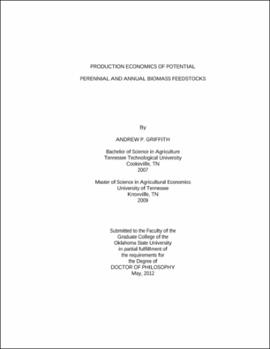| dc.contributor.advisor | Epplin, Francis M. | |
| dc.contributor.author | Griffith, Andrew P. | |
| dc.date.accessioned | 2013-11-26T08:22:00Z | |
| dc.date.available | 2013-11-26T08:22:00Z | |
| dc.date.issued | 2012-05 | |
| dc.identifier.uri | https://hdl.handle.net/11244/6514 | |
| dc.description.abstract | Scope and Method of Study: The first essay determines the lowest cost lignocellulosic biomass feedstock production system for western Oklahoma from among seven alternatives at each of two locations. Field experiments were conducted at the Southern Plains Range Research Station to test production of monoculture (one species) and diverse plantings (many species). The second essay compares crop yields in a continuous wheat system to yields in a canola-wheat system and determines whether the rotation is economically competitive with continuous monoculture wheat for the region in fields infested with feral rye and Italian ryegrass. Field trials were conducted at Lahoma, Lake Carl Blackwell, Chickasha, and Perkins using 24 different treatments for the canola-wheat rotation and eight treatments for continuous wheat. The third essay determines and compares the cost to deliver a year round flow of biomass to a biorefinery for both a system that uses forage sorghum exclusively and a system that uses switchgrass exclusively. A multi-region, multi-period, monthly time-step, mixed integer mathematical programming model was used to determine the cost to deliver a steady flow of biomass to a biorefinery. | |
| dc.description.abstract | Findings and Conclusions: The first essay found biomass yields of diverse mixtures were no greater than yields of monocultures. If the objective is to produce massive quantities of biomass for biorefinery feedstock under the constraint that land area is limited, for the conditions that prevailed at the western Oklahoma locations during the time of the study, internal economics favored monocultures of productive species. The second essay found wheat yields following canola are significantly greater than wheat yields experienced in continuous wheat and expected net returns are greater for canola-wheat rotations than for continuous wheat. A canola-wheat rotation may be an economically viable and effective crop production system for fields traditionally seeded to continuous winter wheat, especially if those fields are infested with feral rye and Italian ryegrass. The third essay found, that given the assumptions used in the study, a switchgrass system would be economically preferable to a forage sorghum system for producing and delivering a year round flow of biomass to a biorefinery. Though forage sorghum has an expected yield advantage over switchgrass and the forage sorghum system is expected to require less nitrogen fertilizer per ton produced, switchgrass has the advantage of a longer harvest window, more harvestable days in a harvest month, and the ability to be produced on both cropland and improved pasture land. By these measures, a flow of switchgrass biomass could be delivered to a biorefinery throughout the year at a lower cost than forage sorghum biomass. | |
| dc.format | application/pdf | |
| dc.language | en_US | |
| dc.rights | Copyright is held by the author who has granted the Oklahoma State University Library the non-exclusive right to share this material in its institutional repository. Contact Digital Library Services at lib-dls@okstate.edu or 405-744-9161 for the permission policy on the use, reproduction or distribution of this material. | |
| dc.title | Production economics of potential perennial and annual biomass feedstocks | |
| dc.contributor.committeeMember | Brorsen, B. Wade | |
| dc.contributor.committeeMember | Doye, Damona | |
| dc.contributor.committeeMember | Kakani, Vijaya Gopal | |
| osu.filename | Griffith_okstate_0664D_12067.pdf | |
| osu.accesstype | Open Access | |
| dc.type.genre | Dissertation | |
| dc.type.material | Text | |
| dc.subject.keywords | canola-wheat rotation | |
| dc.subject.keywords | diversity | |
| dc.subject.keywords | mathematical programming | |
| dc.subject.keywords | switchgrass | |
| thesis.degree.discipline | Agricultural Economics | |
| thesis.degree.grantor | Oklahoma State University | |
